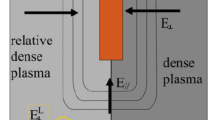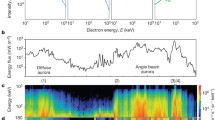Abstract
Aurora is caused by the precipitation of energetic particles into a planetary atmosphere, the light intensity being roughly proportional to the precipitating particle energy flux. From auroral research in the terrestrial magnetosphere it is known that bright auroral displays, discrete aurora, result from an enhanced energy deposition caused by downward accelerated electrons. The process is commonly referred to as the auroral acceleration process. Discrete aurora is the visual manifestation of the structuring inherent in a highly magnetized plasma. A strong magnetic field limits the transverse (to the magnetic field) mobility of charged particles, effectively guiding the particle energy flux along magnetic field lines.
The typical, slanted arc structure of the Earth’s discrete aurora not only visualizes the inclination of the Earth’s magnetic field, but also illustrates the confinement of the auroral acceleration process. The terrestrial magnetic field guides and confines the acceleration processes such that the preferred acceleration of particles is frequently along the magnetic field lines. Field-aligned plasma acceleration is therefore also the signature of strongly magnetized plasma.
This paper discusses plasma acceleration characteristics in the night-side cavity of Mars. The acceleration is typical for strongly magnetized plasmas – field-aligned acceleration of ions and electrons. The observations map to regions at Mars of what appears to be sufficient magnetization to support magnetic field-aligned plasma acceleration – the localized crustal magnetizations at Mars (Acuña et al., 1999). Our findings are based on data from the ASPERA-3 experiment on ESA’s Mars Express, covering 57 orbits traversing the night-side/eclipse of Mars. There are indeed strong similarities between Mars and the Earth regarding the accelerated electron and ion distributions. Specifically acceleration above Mars near local midnight and acceleration above discrete aurora at the Earth – characterized by nearly monoenergetic downgoing electrons in conjunction with nearly monoenergetic upgoing ions. We describe a number of characteristic features in the accelerated plasma: The “inverted V” energy-time distribution, beam vs temperature distribution, altitude distribution, local time distribution and connection with magnetic anomalies. We also compute the electron energy flux and find that the energy flux is sufficient to cause weak to medium strong (up to several tens of kR 557.7 nm emissions) aurora at Mars.
Monoenergetic counterstreaming accelerated ions and electrons is the signature of field-aligned electric currents and electric field acceleration. The topic is reasonably well understood in terrestrial magnetospheric physics, although some controversy still remains on details and the cause-effect relationships. We present a potential cause-effect relationship leading to auroral plasma acceleration in the nightside cavity of Mars – the downward acceleration of electrons supposedly manifesting itself as discrete aurora above Mars.
Similar content being viewed by others
References
Acuña, M. J., Connerey, J., Ness, N., Lin, R., Mitchell, D., Cralsson, C., et al.: 1999, Science 284, 790.
Albert, R. D.: 1967, Phys. Rev. Lett. 18, 368.
André, M., Norqvist, P., Andersson, L., Eliasson, L., Eriksson, A. I., Blomberg, L., et al.: 1998, J. Geophys. Res. 103, 4199.
Barabash, S., Lundin, R., Andersson, H., et al.: 2004, The Analyzer of Space Plasmas and Energetic Atoms (ASPERA-3) for the Mars Express Mission, In Mars-Express — The Scientific Payload, ESA-SP-1240.
Bertaux, J.-L., Leblanc, F., Witasse, O., Quemerais, E., Lilensten, J., Stern, S.A., et al.: 2005, Nature 435, 9.
Brain D., Luhmann, J., Mitchell, D., and Lin, R.: 2005, Expected influence of crustal magnetic fields on the ASPERA3 ELS observations: Lessons learnt from MGS. Paper presented at 1st mars Express Science conference, 21–25 Feb, 2005.
Brain, D. A., Halekas, J. S., Peticolas, L. M., Lin, R. P., Luhmann, J. G., Mitchell, D. L., et al.: 2006, Geophys. Res. Lett., 10.1029/2005GL024782.
Calvert, W.: 1981, Geophys. Res. Lett. 8, 919.
Chaston, C. C., Peticolas, L. M., Carlson, C. W., McFadden, J. P., Mozer, F., Wilber, M., et al.: 2005, J. Geophys. Res. 110, A02211, doi:10.1029/2004JA010483.
Chiu, Y. T., and Schulz, M.: 1978, J. Geophys. Res. 83, 629.
Collin, H. L., Sharp, R. D., and Shelley, E. G.: J. Geophys. Res. 89, 2185.
Dubinin, E., Lundin , R., Koskinen, H., and Pissarenko, N.: 1993, J. Geophys. Res. 98, 3991.
Evans, D. S.: 1968, J. Geophys. Res. 73, 2315.
Evans, D. S.: 1974, J. Geophys. Res. 79, 2853.
Espley, J. R., Cloutier, P. A., Crider, D. H., Brain, D. A., and Acuña, M. H.: 2004, J. Geophys. Res., 2004AGUFMSA13A1120E.
Frank, L. A. and Ackerson, K. L.: 1971, J. Geophys. Res. 76, 3612.
Guglielmi, A. and Lundin, R.: 2001, J. Geophys. Res. 106, 13219.
Gurnett, D. A. and Frank, L. A.: J. Geophys. Res. 78, 145.
Iijima, T. and Potemra, T. A.: 1976, J. Geophys. Res. 81, 2165.
Kallio, E., Barabash, S., Luhmann, J. G., Koskinen, H., Lundin, R., and Norberg, O.: 1994, Geophys. Res. Lett. 99, 23547.
Klumpar, D. M., Peterson, W. K., and Shelley, E. G.: 1984, J. Geophys. Res. 89, 10779.
Krymskii, A. M., Breus, T. K., Ness, N. F., Acuña, M. H., Connerney, J. E. P., Crider, D. H., et al.: 2002, J. Geophys. Res. 107(A9), 1245, doi:10.1029/2001JA000239.
Luhman, J. G. and Schwingenshuh, K.: 1990, J. Geophys. Res. 95, 939.
Luhmann, J. G. and Bauer, S. J.: 1992, AGU monograph 66, 417. In Venus and Mars: Atmospheres, ionospheres, and solar wind interactions.
Lundin, R., Zakharov, A., Pellinen, R., Hultqvist, B., Borg, H., Dubinin, E. M., et al.: 1989, Nature 341, 609.
Lundin, R. and Hultqvist, B.: 1989, J. Geophys. Res. 94, 6665.
Lundin, R., Barabash, S., Andersson, H., Holmström, M., et al.: 2004, Science 305, 1933.
Lundin, R., Winningham, D., Barabash, S., et al.: 2006a, Science 311, 980.
Lundin, R., Winningham, D., Barabash, S., Frahm, R., and the ASPERA-3 team: 2006b, ICARUS, April 2006.
Lyons, L. R., Koskinen, H. E. J., Blake, J. B., Egeland, A., Hirahara, M., Øieroset, M., et al.: 1999, Space Sci. Rev. 88, 85.
MacIlwain, C. E.: 1960, J. Geophys. Res. 65, 2727.
Mitchell, D. L., Lin, R. P., Mazelle, C., et al.: 2001, J. Geophys. Res. 106, 23419.
Moore, T. E., Lundin, R., Alcayde, D., Andre, M., Ganguli, S. B., Temerin, M., et al.: 1999, Space Sci. Rev. 88.
Pérez-de Tejada, H.: 1987, J. Geophys. Res. 92, 4713.
Russell, C. T., Luhmann, J. G., Schwingenshuh, K., Riedler, W., and Yeroshenko, Ye: 1990, Geophys. Res. Lett. 17, 897.
Sharp, R. D., Johnson, R. G., and Shelley, E. G.: 1977, J. Geophys. Res. 82, 3324.
Shelley, E. G., Johnson, R. G., and Sharp, R. D.: Geophys. Res. Lett. 3, 654.
Winningham, J. D., Frahm, R. A., Sharber, J. R., Coates, A. J., Linder, D. R., Soobiah, Y., et al., and the Aspera-3 Team: 2006, ICARUS, April issue.
Author information
Authors and Affiliations
Corresponding author
Rights and permissions
About this article
Cite this article
Lundin, R., Winningham, D., Barabash, S. et al. Auroral Plasma Acceleration Above Martian Magnetic Anomalies. Space Sci Rev 126, 333–354 (2006). https://doi.org/10.1007/s11214-006-9086-x
Received:
Accepted:
Published:
Issue Date:
DOI: https://doi.org/10.1007/s11214-006-9086-x




